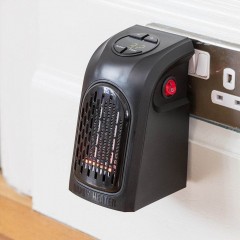Advantages and disadvantages of infrared heaters
Operating principle
The principle of operation is quite simple. Thermal rays pass through the air directly to objects, which in turn transfer heat throughout the room. Thus, the devices do not dry the air and perform their function as efficiently as possible, which is the main advantage of infrared heaters.
It should be noted that in this case the heat is distributed from top to bottom, which is undoubtedly better than from bottom to top (as when heating by convectors and radiators).
Main advantages
Among the main advantages of infrared heaters are:
- rapid heating of the room (within a minute, the heating element reaches the working state);
- products do not burn oxygen;
- lack of noise during the work;
- evenly distribute heat in the room (almost the same temperature at the level of the ceiling and floor);
- long term of operation;
- the possibility of mounting, both on the wall and on the ceiling (do not get confused underfoot);
- environmental friendliness (there are no harmful emissions into the atmosphere);
- create the effect of the system "warm floor»;
- simplicity infrared heater connection do it yourself, in addition, for a short period of time;
- do not fail with power surges;
- can be used for spot heating the room (the design involves the regulation of the scope);
- connected to a temperature regulator, which allows you to save electricity and create optimal temperature conditions;
- fire safety;
- can be used in open or half-open space (for example, on a terrace);
- can apply for heating installation in a bathhouse, bathroom and other rooms with high humidity;
- effectively used together with any type of ventilation system.
As you can see, the advantages of infrared heaters are quite significant, now let's talk about the main disadvantages.
Existing flaws
So, among the main disadvantages of infrared heaters distinguish:
- increased cost of products (to create a full-fledged system of electric heating at home, considerable investments will be required);
- high costs for paying for electricity, if you do not use saving measures (wall insulation, installation of a temperature regulator, two-rate counter etc.);
- negatively affect the well-being of a person with prolonged radiation;
- not recommended for use in rooms with low ceilings (for the reason indicated above);
- due to the fact that the first thing the heat is directed to the walls and indoor objects, there is a possibility of damage to the varnish coating;
- TEN glows red during heating at night, making it difficult to sleep (some particularly picky critics annoy this factor, judging by the reviews on the forums);
- a fairly low level of intelligent control.
To summarize
You have learned the advantages and disadvantages of infrared heaters. As you can see, the advantages of these devices are an order of magnitude greater than the disadvantages. And besides, all the disadvantages are rather contradictory, because with proper use it is possible to save electricity and warm the rooms quite efficiently.
We still recommend that you use infrared heaters, especially if it is to be carried out installation of heating in a wooden house, because this building in itself is very heat-consuming! We also recommend that you read our tips on the choice of electric convectors for the home!








